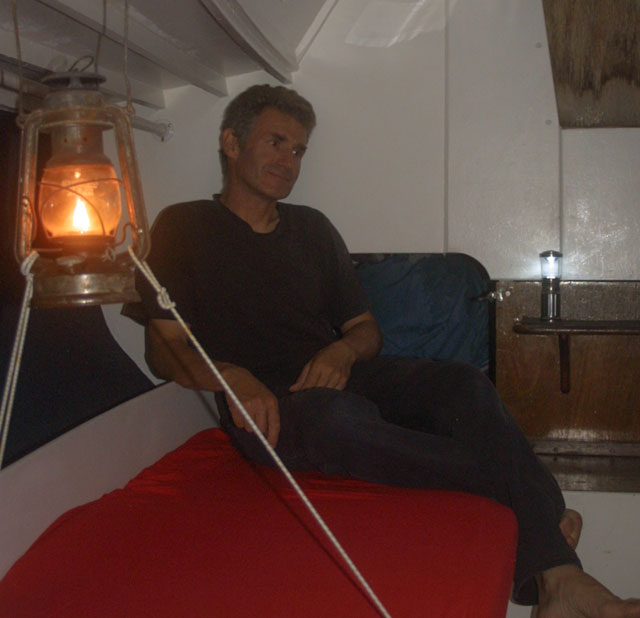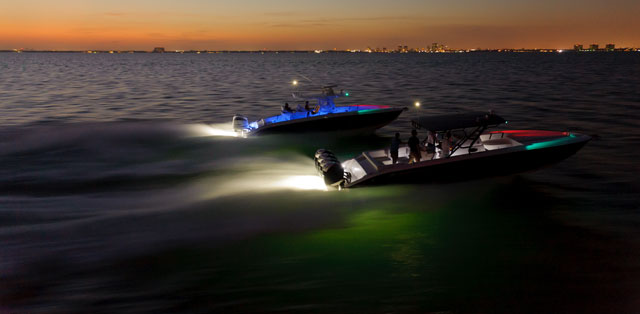Using LED Lighting on your Boat
LED lights are rapidly gaining in popularity for use on board. Rupert Holmes analyses the pros and cons…
June 16, 2012
LED technology has been advancing rapidly since it was first developed 50 years ago and latest types have the potential to save a significant amount of battery drain, using only 10-20 percent of the power needed by traditional incandescent bulbs. They also offer a very significant saving compared to fluorescent alternatives.

You can do some really stunning things with LED lighting. Here OceanLED's lights are used to create underwater lighting as well as provide on-board lighting
The benefit of this to many smaller boats is immediately obvious: a boat with no charging facility other than a solar panel can now realistically run navigation and interior lights with no other input. Similarly, when sailing offshore, there was a time that wondering whether the battery would run the lights through the night often preyed on the skipper’s mind. However, with LEDs that use only a tiny percentage of vessel’s battery capacity, this is not an issue.
Even larger yachts equipped with generators, and in theory almost unlimited electrical power, can benefit from installing LEDs – such vessels tend to be fitted with a huge amount of interior lighting. Although conserving electrical power was not his primary motive, a friend who changed the dozen or so halogen downlighters in the galley of his Swan 62 for LED equivalents reduced the power draw by almost 200W. Repeating that throughout the boat, it translated to a lot less time with the generator running and helped reduce cabin temperatures in the summer.
A further theoretical benefit is longer service life – some models claim 50,000 hours, although in practice some of the early marine navigation lights had a higher level of premature failure than would have been expected. However, these problems are likely to be ironed out as the application of the technology in this area matures.
Drawbacks
While a traditional incandescent bulb is very low-tech – it’s basically a piece of wire that glows when enough current passes through – LED lights are complex components with integrated electronics. This means that not all will work effectively with the variable voltages seen on board boats: a nominally 12V electrical system can increase to up to 16V when the batteries are being charged by the engine or shore power chargers, and may reduce to well under 12V if the batteries are well discharged.
One of the recent changes that’s made a big difference to the aesthetic viability of interior lighting using LEDs is the now widespread availability of ‘warm white’ lighting. Previously ‘white’ LEDs produced a harsh bluish light, rather than a comforting and relaxing warm glow that accentuates the pleasures of life on board. Some people got around this by combining old and new technologies – using a oil lamp in conjunction with LED lighting. Warm white lights also produce relatively true colors when used behind red or green lens for navigation lights, whereas a cool white LED can be used for the white stern, steaming, and anchor lights.
Navigation lights
Replacing incandescent bulbs with LEDs is a relatively cheap option considering the longevity of the fixture, and may be a good option for lights of a single color. However, unlike a conventional bulb, in which the filament forms a single light source at the center of the lamp, the LED replacement is a cluster of LEDs with a much larger overall diameter.
The problem with this is that the clearly defined boundaries between a lamp’s different colored sectors are only be achieved with the discreet single light source. Anything else is a compromise, with a degree of blurring of the boundaries between the colors that may not satisfy the requirements of the authorities.
That’s why companies such as OceanLED, Lupolight and Nasa Marine have developed fully integrated sealed LED navigation lights. These use arrays of different colored bulbs to ensure the sectors are exactly as required by the rules. The downside is that they are relatively expensive.
Before splashing out large sums, consider which lights are worth changing. Conventional navigation lights on a motorboat powered by an inboard diesel engine use only a small percentage of the power that the alternator returns to the batteries. And the lights aren’t used when the engine isn’t running. The situation with sailboats, however, is somewhat different; the masthead tricolor may be run all night on a long passage.
Note that when specifying navigation lights and bulbs it’s important to ensure you choose items that are type-approved by the relevant authorities the territory in which you keep your vessel – this can vary, for instance, between Europe, the USA, and other parts of the world.
Anchor and emergency lights
LEDs are perfect for an all-round white anchor light and it’s possible to get them with an integral light-dependent switch, so that the light automatically comes on at dusk and turns off at dawn. As well as further reducing power drain, it also means there’s no prospect of the boat being unlit at anchor if the crew return from shore later that expected.
LED technology can also be used to good effect with flashlights, search lights, and interior emergency lights. The batteries of these items will last many times longer than with conventional bulbs, which means the devices can also be much smaller.
The future
The technology in this area is still improving, with those changes often rapidly filtering into the consumer market. We can expect the technology to continue developing, particularly in terms of miniaturization.
As the reduced power consumption of LED lights also tends to improve the lifespan of a boat’s batteries, it wil be cost-effective for most leisure boats to replace all frequently used bulbs with suitable LED equivalents.

















